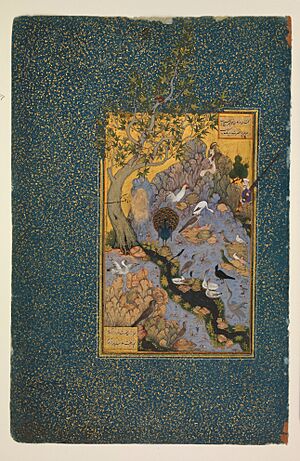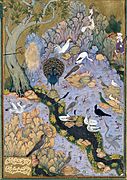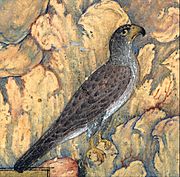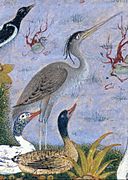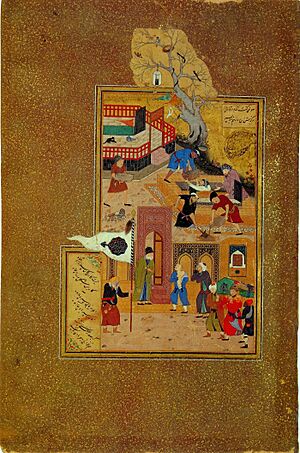Attar of Nishapur facts for kids
Quick facts for kids Attar of Nishapur |
|
|---|---|
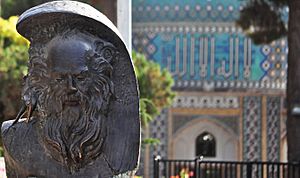
Bust of Attar at his mausoleum
|
|
| Mystic Poet | |
| Born | c. 1145 Nishapur, Seljuk Empire |
| Died | c. 1221 (aged 75–76) Nishapur, Khwarezmian Empire |
| Resting place | Mausoleum of Attar, Nishapur, Iran |
| Venerated in | Traditional Islam, and especially by Sufis |
| Influences | Ferdowsi, Sanai, Khwaja Abdullah Ansari, Mansur Al-Hallaj, Abu-Sa'id Abul-Khayr, Bayazid Bastami |
| Influenced | Rumi, Hafez, Jami, Ali-Shir Nava'i and many other later Sufi Poets |
|
Tradition or genre
|
Mystic poetry |
| Major works | Memorial of the Saints The Conference of the Birds |
Abū Ḥamīd bin Abū Bakr Ibrāhīm (born around 1145 – died around 1221), known as Attar of Nishapur, was a famous Iranian poet. His pen-name, Attar, means "apothecary" or "perfumist". He was also a thinker of Sufism, which is a spiritual path in Islam.
Attar wrote many poems and stories that have greatly influenced Persian poetry and Sufism. His most famous works include The Conference of the Birds, The Book of Divine, and Memorial of the Saints.
Contents
Attar's Life Story
Not much is known for sure about Attar's life, and many stories have grown around him over time. We do know he was born into a Persian family in Nishapur, a big city in what is now northeast Iran.
Attar worked as a pharmacist, helping many people with their health problems. He heard their worries and troubles, which deeply affected him. Because of this, he decided to leave his pharmacy and travel widely. He visited many cities like Baghdad, Mecca, and India. During his travels, he met many Sufi teachers and learned a lot about their spiritual ideas. He then returned home and shared these ideas. Attar was a Sunni Muslim.
From a young age, Attar was interested in Sufism and its spiritual leaders. He saw them as his guides. Sadly, Attar died a violent death when the Mongols attacked Nishapur in April 1221. He was about 78 years old.
Today, you can visit his mausoleum (a special building for a tomb) in Nishapur. It was built in the 16th century and later fixed up in 1940.
Attar's Teachings
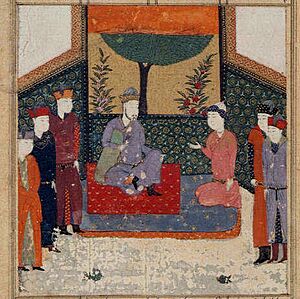
Attar's writings show how the Sufi movement developed. He believed that our souls, which are connected to our bodies, want to return to their original source. He taught that we can experience this spiritual connection in our current life by purifying our inner selves.
To explain his ideas, Attar used stories not only from Sufi teachings but also from older spiritual traditions. His heroes were often Sufis, but he also included tales from history and everyday life. He was very good at finding deeper meanings in ordinary things. This helped him turn simple details into lessons about his spiritual thoughts.
Attar was not very interested in revealing the secrets of nature or medicine, even though he was a pharmacist. He used his knowledge only when it fit into the spiritual themes of his stories.
Attar, along with other famous poets like Rumi and Sana'i, were Sunni Muslims. This is clear because their poems often praise the first two caliphs, Abu Bakr and Umar ibn al-Khattāb.
Attar's Poetry
Attar's most famous poem is The Conference of the Birds (Mantiq al-tayr). Like many of his poems, it is written in a style called mathnawi, which uses rhyming pairs of lines. This style was later used by Rumi in his famous Mathnawi-yi Ma’nawi.
Attar mentioned several of his other works in the introductions to his poems Mukhtār-Nāma and Khusraw-Nāma:
- Dīwān
- Asrār-Nāma (Book of Secrets)
- Manṭiq-uṭ-Ṭayr (The Conference of the Birds)
- Muṣībat-Nāma (Book of Sorrows)
- Ilāhī-Nāma (The Book of Divine)
- Jawāhir-Nāma (Book of Jewels)
- Šarḥ al-Qalb (Commentary on the Heart)
One important work not on this list is Tadhkirat-ul-Awliyā, which is a prose work (not poetry). It is almost certainly written by Attar.
The Conference of the Birds
In The Conference of the Birds, all the birds of the world gather together. They want to choose a king because they don't have one. The hoopoe, who is the wisest bird, suggests they find the legendary Simorgh.
The hoopoe tells the birds they must cross seven difficult valleys to reach the Simorgh's home. Each valley represents a challenge or a human flaw that stops people from reaching spiritual understanding.
These valleys are:
- Valley of the Quest: Where travelers let go of all their old beliefs.
- Valley of Love: Where logic is left behind for the sake of love.
- Valley of Knowledge: Where worldly knowledge becomes useless.
- Valley of Detachment: Where all desires and ties to the world are given up.
- Valley of Unity: Where travelers realize everything is connected, and the Beloved (God) is beyond everything.
- Valley of Wonderment: Where travelers are amazed by the Beloved's beauty and feel they have never truly understood anything.
- Valley of Poverty and Annihilation: Where the self disappears, and the traveler becomes timeless.
Many birds are scared and some even die before the journey begins. Those who start face many dangers like thirst, sickness, and wild animals. In the end, only thirty birds make it to the Simorgh's home.
When they arrive, they learn a surprising truth: they themselves are the Simorgh! The name "Simorgh" in Persian means "thirty birds" (si means thirty, morgh means bird). They realize that the greatness of the Beloved is like the sun reflected in a mirror. When you look into that mirror, you also see your own reflection.
Attar uses many symbols in this poem. For example, when he mentions China, it's not the country. Instead, it's a symbol for a deep spiritual experience. Attar also tells many short, wise stories within the main journey of the birds.
Gallery of The Conference of the Birds
These images are from an old manuscript (handwritten book) of The Conference of the Birds, made around 1600. They are now in the Metropolitan Museum of Art in New York.
Memorial of the Saints
The Tadhkirat-ul-Awliyā (Memorial of the Saints) is Attar's only known prose work. It is a collection of stories about famous Muslim saints and mystics. Attar worked on this book for much of his life. One well-known part of the book tells the powerful story of the mystic Mansur al-Hallaj, who famously said "I am the Truth" during a deep spiritual moment.
The Book of Divine
The Ilāhī-Nāma (The Book of Divine) is another famous poem by Attar, with about 6,500 lines. It is similar in style and content to The Conference of the Birds. The story is about a king whose six sons have many worldly desires. The king tries to show them how pointless these desires are by telling them many spiritual stories. Each son's desire is discussed, first literally, then explained with a deeper, spiritual meaning.
Collection of Quatrains
The Mukhtār-Nāma is a large collection of 2,088 quatrains (four-line poems). These poems cover many mystical and religious topics, such as the search for spiritual union, the feeling of being unique, letting go of the world, and the awareness of death. They also include themes common in love poetry, like the pain of love and the beauty of the beloved.
Divan
Attar's Divan is mostly made up of poems called Ghazals, which are lyrical poems. He collected his shorter four-line poems (Ruba'i) in a separate work called the Mokhtar-nama. The Ghazals often seem like love songs or wine songs, but they usually have a deeper, spiritual meaning, using symbolic language common in Sufism. Attar's lyrical poems express the same ideas found in his longer narrative poems.
Attar's Legacy
Influence on Rumi
Attar is one of the most famous mystic poets from Iran. His works greatly inspired Rumi, another very famous mystic poet, and many others. Rumi often spoke highly of Attar in his own poetry. Rumi once said:
Attar has roamed through the seven cities of love while we have barely turned down the first street.
This shows how much Rumi respected Attar's spiritual journey and wisdom.
As a Pharmacist
Attar was a pen-name he chose because of his job. "Attar" means herbalist, druggist, or perfumist. In his time in Persia, much of medicine relied on herbs. So, he was like a modern-day town doctor and pharmacist. The word "Attar" also refers to rose oil.
See Also
 In Spanish: Farid al Din Attar para niños
In Spanish: Farid al Din Attar para niños
- Sufism
- The Seven Valleys
- Mir Sayyid Ali Hamadani
- Sheikh San'Aan


